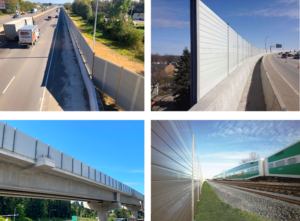Sound barrier walls offer effective noise-pollution solutions
Noise pollution is a pervasive issue in our modern urban environments and is often underestimated in terms of its impact on our health and well-being. In this article, we explore the hidden dangers of noise pollution and shed light on how sound barrier walls can play a crucial role in mitigating these dangers.
Excessive noise, such as that from transportation corridors, negatively affects our physical and mental health
As reported in Psychology Today, a growing body of evidence confirms that noise pollution has both temporary and permanent effects on people by way of the endocrine and autonomic nervous systems. It has been postulated that noise acts as a nonspecific biologic stressor, eliciting reactions that prepare the body for a “fight or flight” response.
Acute exposure to noise activates nervous and hormonal responses, leading to temporary increases in blood pressure, heart rate and vaso-constriction. Studies of individuals exposed to occupational or environmental noise show that exposure of sufficient intensity and duration increases heart rate and peripheral resistance; increases blood pressure; increases blood viscosity and levels of blood lipids; causes shifts in electrolytes and increases levels of epinephrine, norepinephrine and cortisol. Sudden unexpected noise evokes reflex responses as well.
For this reason, noise can trigger both endocrine and autonomic nervous system responses that can have a number of negative health effects including:
- Cardiovascular disease such as coronary artery disease and high blood pressure
- Stress-related conditions such as migraine, colitis and ulcers
- Sleep disorders
- Emotional problems such as mental fatigue, anxiety and aggression
- Physical and cognitive developmental problems in children
Chronic noise impacts more than 100 million Americans
In 2023, The New York Times published an article called “Noise Could Take Years Off Your Life. Here’s How.” Professional sound meters were used to measure the din of daily life and the authors talked to scientists about the health risks it could pose. A growing body of research shows that chronic noise is not just annoying. It is a largely unrecognized health threat that is increasing the risk of hypertension, stroke and heart attacks worldwide, including for more than 100 million Americans.
People do not really adapt to unwanted noise from transportation corridors
Anyone who lives in a noisy environment, like the neighborhoods near busy highways or light rail transit lines, may feel they have adapted to the unwanted noise. But data shows the opposite: Prior noise exposure primes the body to overreact, amplifying the negative effects.
To understand this pathway, researchers broke it down: They scanned the brains of people as they
listened to unpleasant sounds and watched live as their amygdalas — the portions of the brain that control emotional response and other functions — became activated.
To simulate relentless nights, scientists played dozens of sporadic recordings of passing trains and
planes overhead in healthy volunteers’ bedrooms — recordings taken of real disruptions from people’s homes. They found that the next morning, the volunteers had higher adrenaline levels, stiffened arteries and spikes in plasma proteins that indicate inflammation.
High levels of transportation corridor noise were more likely to lead to major cardiac events
When researchers analyzed the brain scans and health records of hundreds of people at Massachusetts
General Hospital, they made a stunning discovery: Those who lived in areas with high levels of transportation noise were more likely to have highly activated amygdalas, arterial inflammation and —
within five years — major cardiac events.
The associations remained even after researchers adjusted for other environmental and behavioral factors that could contribute to poor cardiac health, like air pollution, socioeconomic factors and
smoking. In fact, noise may trigger immediate heart attacks: Higher levels of aircraft noise exposure in the two hours preceding nighttime deaths have been tied to heart-related mortality.
The nighttime noise that a person experiences in such an environment is considered particularly detrimental to health because it can fragment sleep and trigger a stress response, even if the person does not recall being roused.
How much transportation corridor noise is too much?
According to the World Health Organization (W.H.O.), average road traffic noise above 53 dB is associated with adverse health effects. Nearly a third of the U.S. population lives in areas exposed to noise levels of at least 45 dB, according to a preliminary analysis based on models of road, rail and aircraft noise in 2020 from the Department of Transportation.
The W.H.O. has long recommended less than 40 dB as an annual average of nighttime noise outside bedrooms to prevent negative health effects, and less than 30 dB of nighttime noise inside bedrooms for high-quality sleep.
Mounting research suggests that the relationship between noise levels and disease is eerily consistent:
A study following more than four million people for more than a decade, for example, found that, starting at just 35 dB, the risk of dying from cardiovascular disease increased by 2.9 percent for every 10 dB increase in exposure to road traffic noise.
People have been aware of the health-related dangers of air pollution for decades and governments around the world have worked to reduce smog and similar air-quality problems. But there has been little progress to reduce the sound pollution that surrounds us daily. Perhaps it is because unlike smog, sound waves aren’t visible. If we could “see” sound, we might be alarmed by how much harmful noise we are exposed to every day.
Sound barrier walls offer effective noise-pollution solutions along transportation corridors
Fifty years ago, under the Noise Control Act of 1972, the newly formed Environmental Protection Agency
was a trailblazer in recognizing the danger of noise and addressing it: It educated the public, established safety limits, published deep analyses on various culprits and recommended actions to mitigate harm.
But its office of noise abatement was defunded by the Reagan administration, rendering policies unenforceable and regulatory criteria obsolete.
Europe leads the world in noise pollution solutions
European countries have far outpaced the rest of the world in regulating noise. The European Union
requires member nations to monitor and assess sound levels across regions and to produce new action plans every five years to address communities at greatest risk. While scientists say it’s too soon to make a prediction about the effects of these policies on cardiovascular health, several European countries have reported tens of thousands fewer residents exposed to major sources of noise.
Like many health issues, protection against noise would be economically advantageous. Economists
who analyzed health-care spending and productivity loss because of heart disease and hypertension have argued that a 5 dB reduction in U.S. noise could result in an annual benefit of $3.9 billion.
But unlike most other contributors to heart disease, noise cannot be addressed fully between a patient and a doctor. Protection requires changes in local, state and federal policy.
How sound barrier walls offer solutions in different applications
The first purpose-built noise barriers in North America were installed in California in 1968; since then, noise barriers have steadily grown in popularity. In fact, noise barriers are the dominant type of mitigation measure adopted in most states to reduce unwanted road or rail noise.
With the ever-increasing use of sound barriers, research into their design, performance and cost efficiency has also increased. While early noise barrier wall systems were massive and more costly structures made of wood, metal or concrete, the market has evolved and matured to favor more efficient and sustainable solutions — often with more sound-absorptive technology or materials.
In fact, many of the earlier sound walls are being replaced today by more sustainable and effective solutions such as lightweight PVC sound walls.
Today’s lightweight PVC noise barrier wall systems offer effective noise pollution solutions
Modern innovations in noise barrier wall systems, like those from the AIL Sound Walls R&D team, are leading the way to more cost-effective and sustainable sound barrier wall construction solutions compared to other materials.
Lightweight PVC sound barrier walls from AIL Sound Walls are available in both absorptive and reflective systems with some of the industry’s highest Sound Transmission Class (STC) and Noise Reduction Coefficient (NRC) ratings.
They are ideal economical installations on narrow job sites along urban transportation corridors like highways or light rail transit systems. In addition to ground mounting, their lightweight versatility allows them to be installed in many ways, such as mounted to traffic barriers, bridge parapets or LRT guideways as shown in these images.

There’s an AIL Sound Walls specialist ready to help you value engineer a better solution for your sound-mitigation project — and the sooner they get involved in the process, the more you may save. Call toll-free 1-866-231-7867 to get started.






